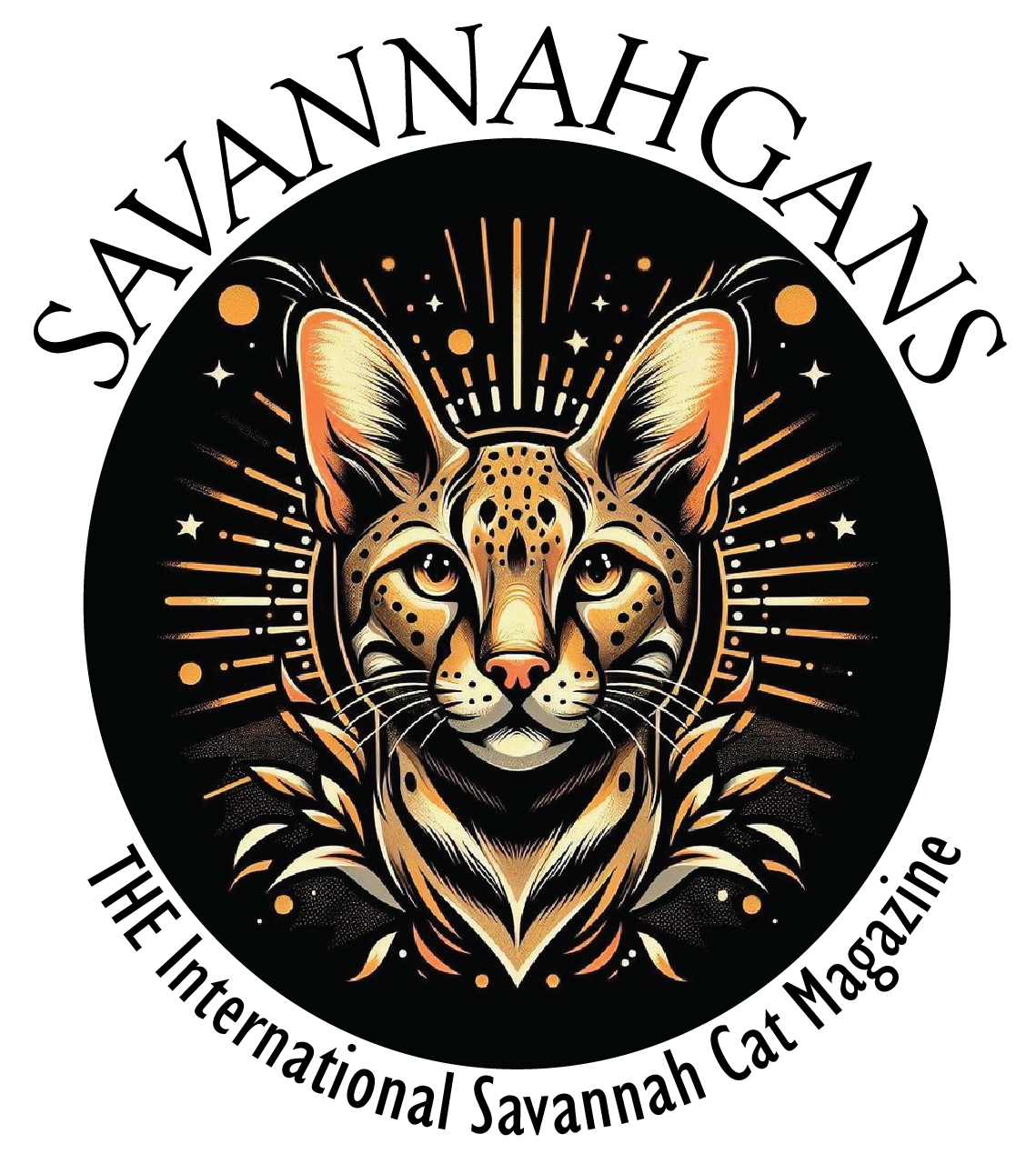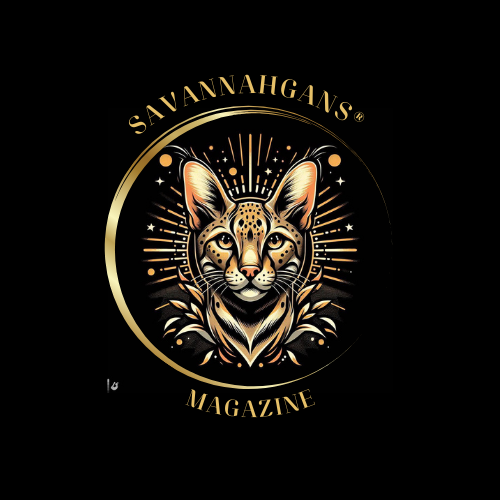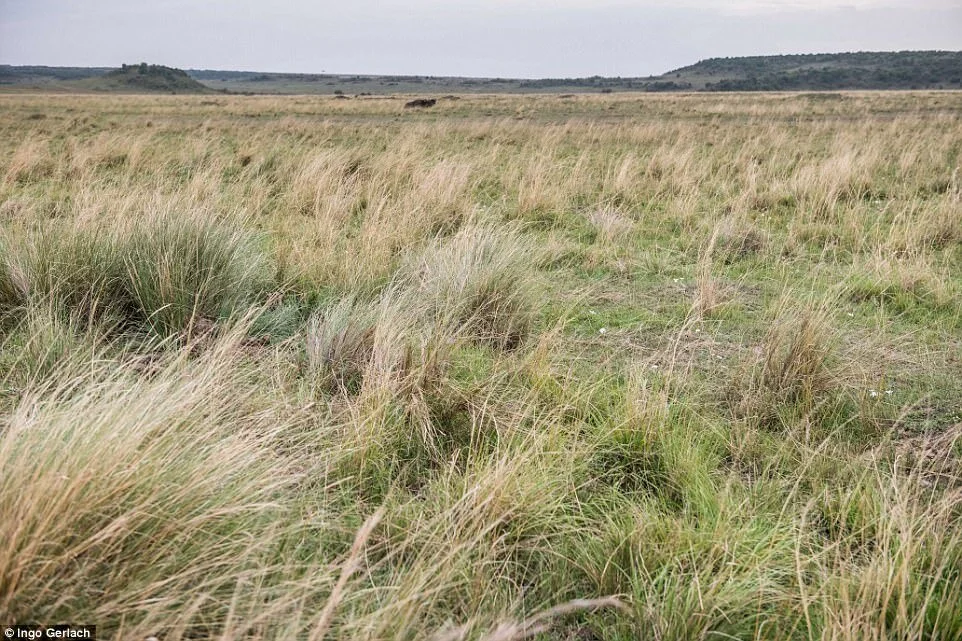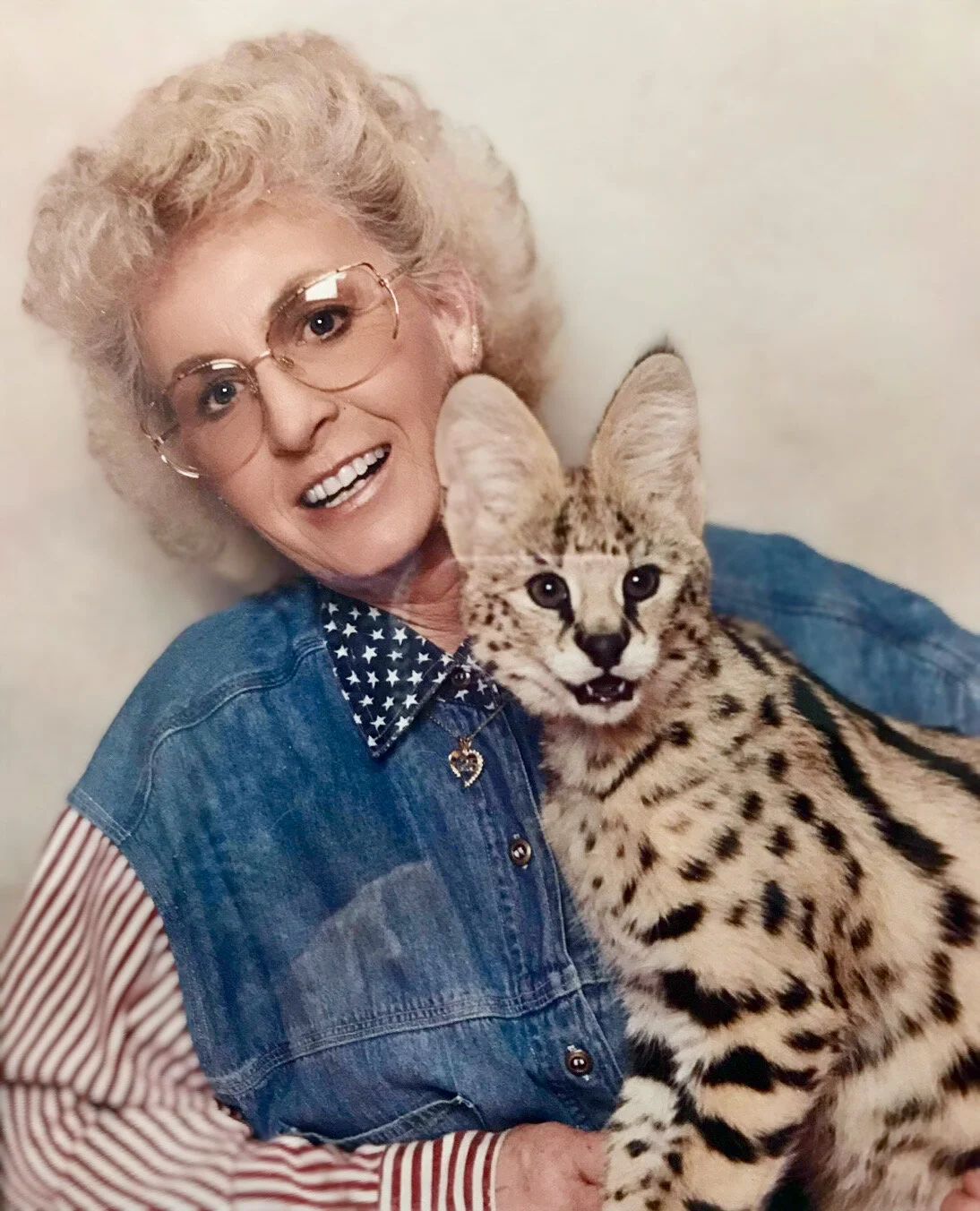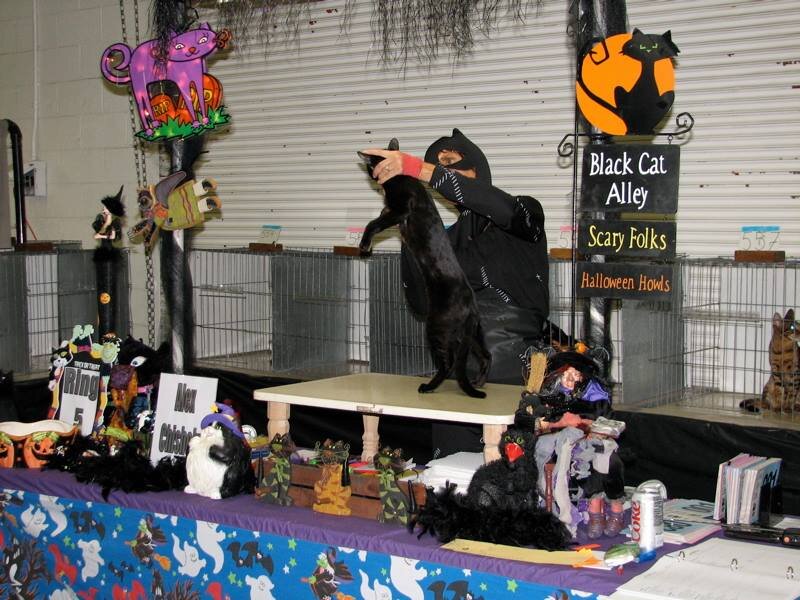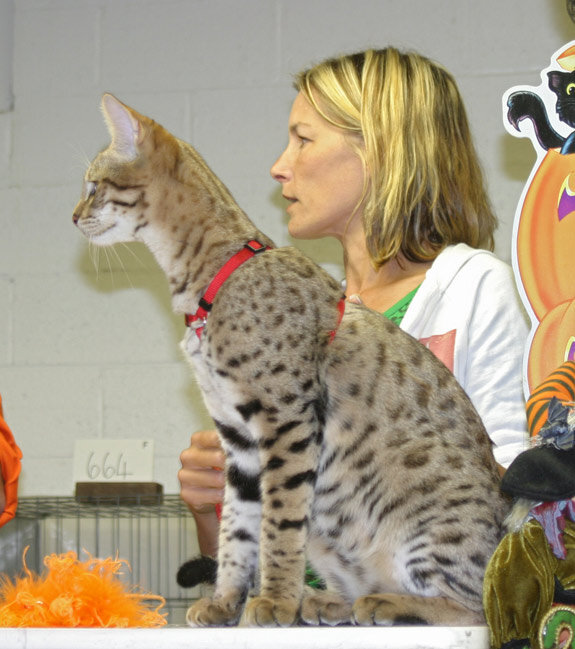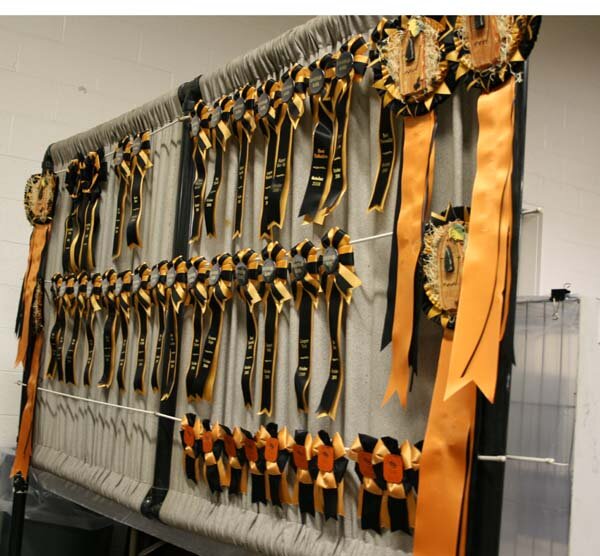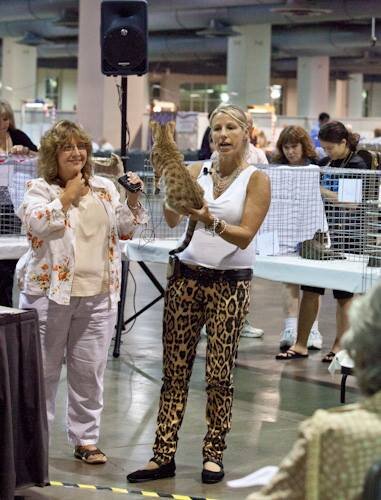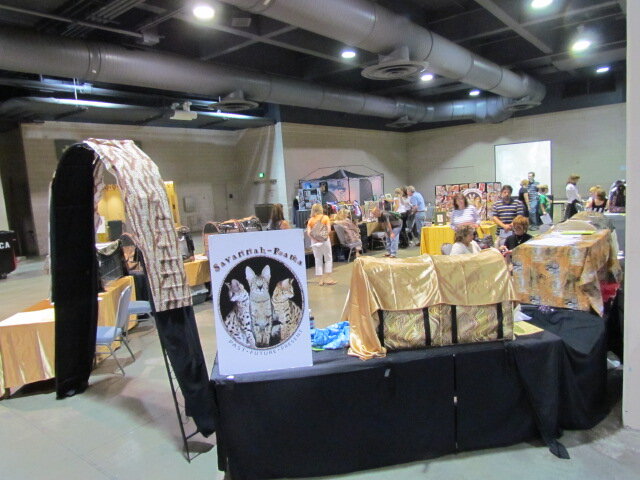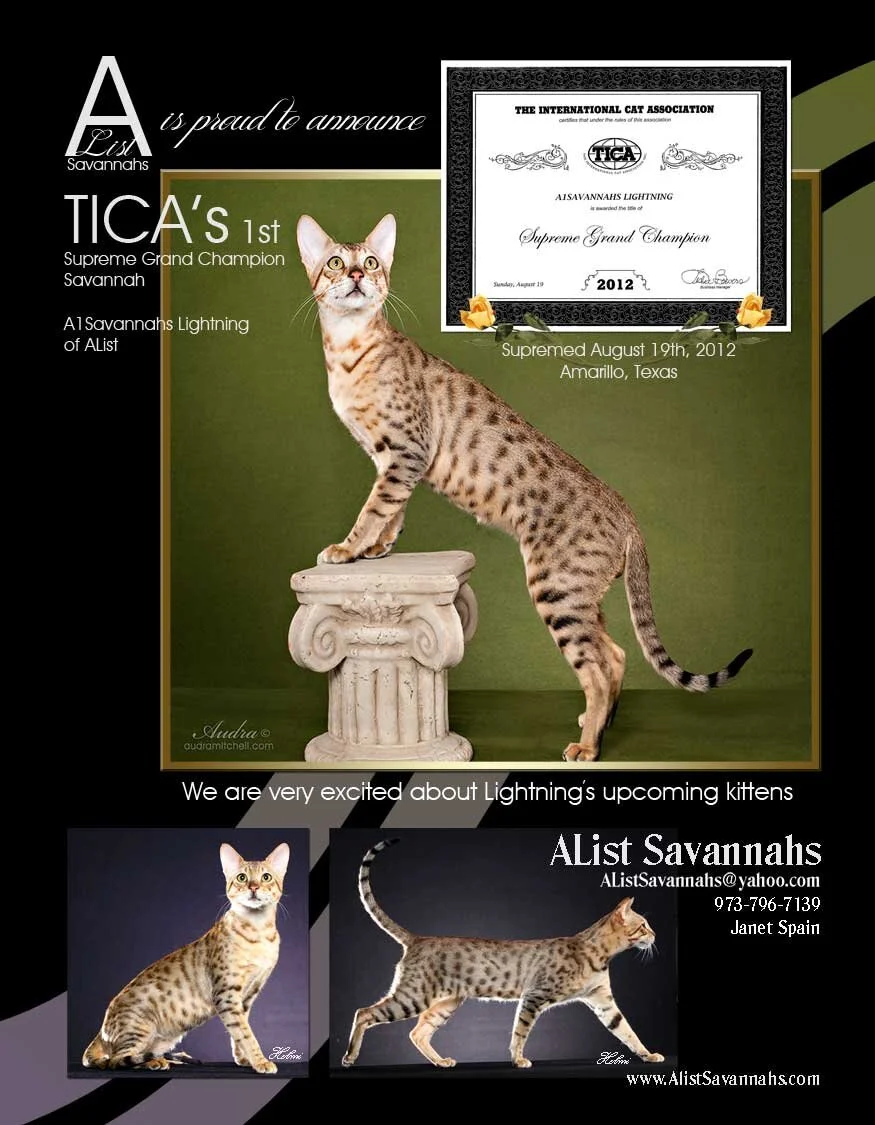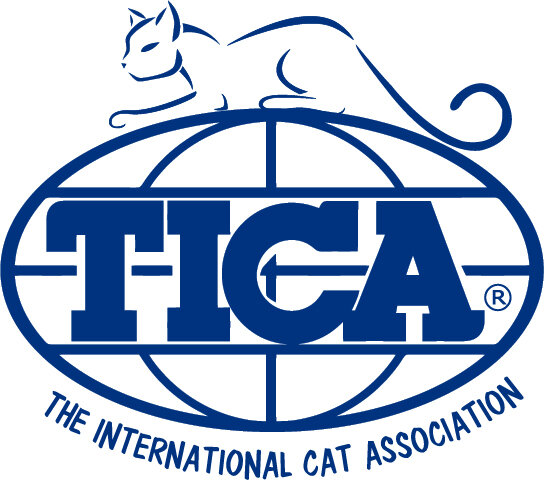A Timeline of the Savannah Cat Breed’s Development from 1986 to Present Day
The Savannah cat breed's miraculous story starts with the surprise birth of a single Serval-domestic hybrid kitten. From there, it evolved with several breeders responsible and recognized for the founding and progression of the Savannah breed, gaining The International Cat Association (TICA) Breed Recognition. Without TICA's recognition, the Savannah cat was nothing more than a hybrid cat, not an actual breed. The history is, however, not without discrepancies in some of the earlier details. I've shared the information obtained in the most neutral way possible, respecting the accuracy and details as presented. Continue reading about the challenges and the visionaries who meticulously and carefully bred for a specific set of characteristics, shaping the Savannah breed into what it is today.
Special thanks to Patrick Kelley and Joyce Sroufe for the many enlightening discussions for this deep dive into early breed history and Brigitte Cowell Moyne for the endless resources for achieving breed recognition and more. I feel it's vital for Savannah owners and enthusiasts to know the backstory of the breed's creation to be where it is today. Don't hesitate to contact me if anyone has anything to add to the history, as this timeline is ongoing.
**If referencing this article or its contents on other websites or in publications, please attribute as follows: "Source: https://www.savannahgans.com/blog-1/savannah-cats-breed-timeline". Please email savannahgans@gmail to tell us where you've shared our information.
—1986, The first Savannah Cat came when a domestic Seal Point Siamese cat and a 35lb African Serval named "Ernie" crossbred. The eight-ounce kitten, originally called" Miracle," was born under the temporary care of Judee Frank in Philipsburg, PA (a Bengal breeder). The Serval and Siamese belonged to Suzi Wood Mustacio (from Alabama), and Judee was housing the pair for Suzi during a divorce. Some sources say there was a plan to breed Ernie to Judee's female Serval, and Suzi would retain one of the offspring.
Eight-ounce "Miracle" was born on April 7, 1986. This first-generation hybrid cross possessed the traits of both a domestic cat and an African Serval, having black Serval-like spots, long legs, tall ears with ocelli (silver spots on the back of the ears), and a short-medium tail length. Miracle's weight at birth and as she grew was comparable to an average serval cub of the same timespan. Her rapid growth and weight gain tapered off, but she remained consistently larger than a domestic kitten of the same age and was ten pounds at six months of age. When Judee turned Miracle over to Suzi, she renamed the kitten "Savannah," Judee never saw them again. Sources say Judee didn't intentionally breed the pair and was surprised to find the new kitten and mother in a box. Suzi eventually returned to pick up her cats, which included "Savannah."
Judee Frank unintentionally produced the first Savannah, an F1 (Serval "Ernie" + Seal Point Siamese = F1 Hybrid "Miracle," later renamed to "Savannah")
Suzi Wood wrote in the "Long Island Ocelot Club's Newsletter" in 1986 (LIOC): "While rumors say this type of hybrid was bred some years ago, to date, research efforts in Europe as well as here in the US have not been able to document the case. For practical purposes, this kitten is considered a first of its kind as there was no comparison model or standard. They tested the new infant's hearing, sight, reflexes, and coordination at eight weeks. All functions were excellent, as compared to general feline skills." Suzi also noted no adverse reactions to the cat flu vaccination. She finished the report by stating, "This hybrid combination will be known as the Savannah." Suzi wrote two articles about "Savannah." (links in the reference section)
Suzi was interested in breeding F1 "Savannah" back to a domestic cat to produce F2's. However, nothing was known about the fertility between a Savannah cat and a domestic to create such a hybrid. The Bengal cat had been around for over 15 years when the Savannah Cat was firstborn. Difficulties producing the Bengal cat and the temperament inherited by the Asian Leopard cat into the first generations of Bengals likely put breeders off from wanting to try other hybrid crosses, such as the Savannah.
Lori Buckho and “Albert II”. Photo courtesy of Patrick Kelley.
—1989 Surprisingly, F1 "Savannah" was indeed fertile, and at 15 pounds, Suzi successfully bred her to a 13-pound male "Turkish Angora" Champion cat. Albert II. Lori Buchko of Hightstown, New Jersey, owned Albert II. The pair produced several litters of F2s (called "second-generation hybrid crosses"), but all died except one F2 female, named "Kitty." This successful breeding showed hope the Savannah Cat could prevail as a new breed, but there was the issue of survival. (A Serval's gestation period is one week longer, therefore the risk of premature kittens).
The first litter of "Savannah's" F2 kittens to survive was born on April 5, 1989. Of the two live F2 kittens, one was a male (name unknown), and the other a female named "Kitty." Lori Buchko gave (or sold) the surviving F2 "Kitty" to Patrick Kelley.
Suzi Wood Mustacio produced the first F2 Savannah kittens from her FI" Savannah," aka "Miracle."
The above photos are from "The Feline Conservation Federation," Volume 41, Issue 5—September/October 2007, and initially published in the LIOC-ESCF July/August 1989 Newsletter by Suzi Wood Mustacio.
During my interview with Patrick, he told me he first became intrigued about this possible new breed when he came across one of Suzi's articles above about F1 "Savannah." Patrick's fascination with a Serval/domestic cross started in the early 1990s after visiting a Bengal and exotic cat breeder in Tarzana, CA, Jan Giacinto. While visiting Jan's home, he caught a glimpse of her Serval cat, having never before seen this type of cat. The Serval was huge in comparison to her Bengal cats. Patrick asked Jan if anyone had ever created a hybrid from a cat such as the Serval, and she said she'd "heard of someone, but they weren't worth anything." She brought Patrick's attention back to the Bengals, but it was too late. He'd already begun to think about how a Serval/domestic cross could become the next breed of cats.
Because Patrick had high hopes of starting a new breed of domestic cats with a wild spotted look, he tracked down Judee and Suzi, the two women responsible for this rare Serval/domestic cross. Both women thought the cross was interesting but were unsure of the worthiness of becoming a new breed. Patrick's background wasn't with cats--other than reading about domestic, wild, and hybrid cats at the library. But regardless, he was obsessed and read everything he could get his hands on—but was still far from being an expert. Nevertheless, he felt with absolute certainty that this breed (which Suzi had already coined as the "Savannah") would be a big hit. As mentioned above, Suzi had come to forever own "Savannah" and kept her for future breeding, but Patrick did acquire from Suzi the only female kitten "Savannah" ever produced, F2 "Kitty." One female Savannah cat wasn't much to start a whole new breed with, so Patrick began looking for other cat breeders to join him in pursuing the Savannah Breed. His search included breeders of Serval and Bengal cats.
"Jeanette "Jan" was a longtime breeder of exotic cats from the 1950s-1990s. She passed away in 2008 following a traffic collision in 2007 at 83. Jan is known for her expertise in all exotic cats such as lions, tigers, and jaguars. Her cats appeared in commercials, and TV shows, including Howdy Doody, the Rockford Files, and Animal Planet. She sold cats to many celebrities, and her smaller exotics were taken to schools for show and tell presentations as Jan enjoyed teaching children about exotic felines.
Patrick later ran into Bill Sroufe at an auction in Missouri where he was selling Serval kittens for his wife, Joyce Sroufe, a breeder of Bengal Cats, Servals, and Caracals. Patrick stated in our interview that he had also read about Joyce through magazines called" Animal Finder Guide" and "Cat Fancy Magazine" for Bengals and began communicating with her about this new breed. This trio of events brought Joyce and Patrick together to talk about the breed, and Patrick stated they talked a lot over a few years. There are discrepancies during those first years of the breed development, but what is certain is the work the two did together to write the original version of the "Savannah Breed Standard" to present to the TICA Board of Directors. Both went on to become very successful and longtime Savannah breeders.
—1995 Patrick Kelley of Figtree Felines went on to successfully breed "F3" Savannahs (From his F2 "Kitty") and register them with TICA.
("Tarzan" was the son "Kitty" and a Turkish Angora, making him an F3) but of course, he was sterile, which we now know to be the case with higher-generation Savannahs. Patrick shared that while other kittens were in the litter with Savannah and Kitty, most didn't survive. Also of note, some of Kitty's littermates were pure white!
Joyce’s racehorse barns became her state-of-the-art breeding facilities.
During my interview with Joyce, she shared her background with various wild cats and as a breeder of Bengal cats (New Horizon Bengals). She also learned about Serval/domestic breeding from an article in the Animal Finder Guide. Joyce started saving baby Servals in 1989, raising them with domestics (later generations Bengals). It took two years before any successful breeding took place in creating F1 Savannahs, and some of those early births were premise. A few F1 females made it, but as anyone who’s ever bred F1s knows, it’s a hit and many misses. The older the male Serval gets, the higher the chances he will kill the female he mates. I‘ve shed many tears over the losses of domestic females and premature kittens.
Joyce said no one had the facilities she did to properly house many types of exotic and domestic cats for breeding or her knowledge of the cats. She said people loved beautiful wild animals and wanted to own one, but their care often diminished into neglect. Therefore, the demand for a larger hybrid cat better suited for family living existed. That’s when Joyce’s Savannah breeding program was born.
Joyce was already breeding F1 and F2 Bengals (one of the first hybrid breeds), and people loved their looks and personality. She also had several pairs of breeding Servals, making it easy to start her Savannah program from the ground up with Servals, Bengals, Egyptian Maus, and Oriental Shorthairs, which is how the foundation started.
Joyce added that because she lived rurally with poor internet connections, she couldn’t connect or keep up with much of the new breed information, often resulting in miscommunication of the facts. Breeding took immense trial and error, and there was no DNA testing back in the day—just good old-fashioned breeding and “see what happens.”
Bill and Joyce Sroufe
When Joyce had seven sets of breeding Servals (all from different bloodlines), no one else in the private sector was breeding them. 100% of the male Servals used in those early days were her Servals. They were sold as babies and raised with domestics (of the Serval’ss choosing) to breed for Savannahs. Today, you can see the influence of street cats (the multitudes of colors), Maine Coons (longer hair and pointed ruffed ears), Oriental Short Hairs (rat tails, cleft palates, lazy ears set too far on the side of the head), and the list goes on as to what every breed used did either for—or against—the breed. Not to mention the genetic weaknesses domestic cats brought into the Savannah breed, including some bad temperaments.
Initially, people had no idea how quickly Serval genetics can dilute. Joyce explained there were no fertile Savannah males in the early years, so all F1, F2, F3, and F4 females had to be bred to domestic males. Breeders would then take that fertile male and start breeding back to those females hoping to get a male to breed back over your typeset 1-2-3-4-5 females. She added that by the time you breed away from the Serval, you tend to lose size and type. By the time you get to the F4 and F5 generations, the domestic influence can predominate.
Joyce acknowledged two women who picked up in places where she had limited time: Carol Streit of C and C Savannahs and Janet Spain Rohrbaugh of A-list Savannahs. Carol put together the first Savannah Rama in 2004 and was the Working Group Chair appointed by TICA while in the New Breed Program.
Due to Joyce’s perseverance, faith in this breed, and extensive knowledge and skills in cat breeding, she produced more Savannahs, including many F1s, than any breeder at the time. She was also one of the first to breed down to the later generations and produce fertile males.
Joyce sold her cattery to Martin and Kathryn Stucki, who operated A1 Savannahs for about ten years. She said they’d spend a week at a time with her (roughly three months total) learning about the cats to gain an excellent working knowledge and foundation. She was still nearby to help them as questions arose. It’s unclear what happened, but they sold everything and moved within a few years. The next owners were Martin and Amanda Engster, who purchased A1 in 2013.
Joyce has been retired from breeding for over 30 years, resides in Oklahoma, and currently owns one Savannah, age13, a Sphinx,14, and a Yorkshire Terrier,14.
—1995 Sue Armstrong, a Bengal breeder in the San Fernando Valley California area, was contacted by Patrick (also from this area) when he was trying to find breeders to help develop the Savannah breed. Sue had been breeding early-generation Bengals since 1990 and showed her cats all over the California area. That’s when she learned about Savannahs and that Joyce was on board.
—1995 Lorre Smith Lemire of Afrikan Savannah Cats in Tennessee was a Bengal breeder who began breeding Savannahs. Lorre met her first Serval while on a trip with a friend who was going to pick one up and purchased one herself. Lorre became one of the first to breed the F1 Savannah Cat.
—1995 Doreen Boileau of Drinkwatercats is also an original breeder of the F1 Savannah and a pioneer in breeding Savannahs since the 1990’s when the Savannah was still experimental. Doreen is a long-time holder of the Class II Florida Fish and Wildlife License and was one of the early breeders mentored by Joyce. Doreen shared the extent to which the original breeders would count on one other and share their experiences—the trials, errors, tears, and the many losses that came during those first years. Doreen owns a Serval sire who produced the most F1 Savannahs in the breed's history. He was amazing and loved all girls, breeding them all! His name is Timbuck Two of Drinkwater, and he has since retired. This was a big deal because many Servals turned mean or only bred with one female.
—1995 Gary Fulgham of Jungle Touch Savannahs started breeding Savannahs, specializing in F2s and an occasional F7 litter.
—1996 Patrick Kelley, Joyce Sroufe, and a Bengal breeder, Karen Sausman, wrote the original version of the “Savannah Breed Standard” and presented it to the TICA Board of Directors in February.
THE SAVANNAH BREED STANDARD
—1997 Joyce Sroufe introduced the breed to the public via an exhibition at a major cat show in Westchester, New York. She gave the judges their first look at a Savannah Cat. In the second year, Joyce and her Savannahs were featured headliners of the show and made television appearances and interviews by 20/20, CNN, People Magazine, and others.
—1998 Patrick Kelley’s website Savannahcat.com is born and is still active today!
The logo then…
The logo today.
—1998 Another TICA moratorium was set to halt any new cat breeds, making the Savannah breed’s future, still again, uncertain. The breeders involved started to lose hope that this beautiful new breed of cat may never become officially accepted as a legitimate breed.
—1999 Gary Fulgham of Jungle Touch Savannahs formed an email group on Yahoo to network with other Savannah breeders and develop a “community” of Savannah breeders where they could exchange information and share experiences concerning Savannah cats, in particular, “F1” Savannahs. This group became an excellent resource for these early breeders and became the foundation of the Savannah Cat Breed Section. The group was in existence for about 15 years.
—2000 With the help of Leslie Bowers, executive secretary of TICA, Patrick Kelley completed the first application to get the Savannah breed accepted by TICA into the New Breed program. Patrick was, and continues to this day, instrumental in developing and promoting the Savannah Cat Breed.
—2000 In September, at the annual TICA board meeting, the second moratorium ended, and the New Breed Program began. This original handful of breeders started to meet to revise and clarify the Savannah Breed Standard. By October 2000, Lorre Smith submitted the New Breed Standard to TICA, requesting the Savannah Breed advance to “Registration Only” status. Lorre’s efforts when she was a TICA judge lifted the moratorium, and the Savannah began its progression. It took four years before TICA finished their internal reorganization before the Savannah Cat Breed was finally issued formal breed recognition status this year.
—2000 Margitta Graeves of Kiwanga Savannahs in Germany was one of the only breeders in Europe and a Savannah Cat pioneer, mentor, and advocate. She carefully selected her outcrosses and weeded out cats to keep those who exhibited the traits wanted in Savannahs. For the next two decades, many breeders in the United States imported cats from Kiwanga Savannahs simply because her cats were so impressive in type. Adding a cat from Kiwanga to a breeding program was worth the bother and expense. Look at the pedigrees of Savannahs with superior physical type, and you’re bound to find Kiwanga mentioned. Sadly, Margitta passed away suddenly in 2019. Her tribute article is here.
—2000-2005 Savannah International Member and Breeder Association (SIMBA) Simba was a membership dues club created by Lorre Smith Lemire. After electing their first Board of Directors, things started looking up for the breed. Once accepted for "Registration Only" status, SIMBA board members helped many breeders become TICA members and provided forms to register existing Savannahs and Servals during their first year. SIMBA grew from the original 18 breeders to 30, and Savannah breeders registered over 100 Savannahs. Next, they showed their Savannahs to judges, other exhibitors, the general public, and the world. Cynthia King of Kasbah Cattery was the only other SIMBA President. Also, he ran an "introduction service" for kittens and buyers, allowing breeders who weren’t online in the early 2000s to connect with buyers more easily. SIMBA disbanded in 2005. Doreen Boileau of Drinkwater cats drew the cat in the logo's middle.
—2001 TICA assigned the Savannah cat to "Registration Only" status that February, a big step for the Savannah breed. The original eighteen Savannah breeders began to register their Savannahs and help other new breeders become TICA members. In October, the Savannah breed unanimously became accepted for exhibition, meaning any Savannah cat of the F3 generation or later could be exhibited in the show halls.
The TICA board accepted the Savannah Breed for “Registration”. The Savannah comes in many different colors and patterns; however, TICA Breed Standards accept only spotted patterns with specific colors and color combinations. The Savannah's coat must have a spotted pattern to be accepted by the TICA breed standard. Non-standard patterns and colors include rosettes, marble, snow (point), blue, cinnamon, chocolate, lilac (lavender), and other diluted colors derived from domestic sources of cat coat genetics.
—2001 Brigitte Cowell Moyne of Kirembo Savannahs and Kristine Alessio of Gattobello Savannahs, both from California, have a unique partnership in their breeding efforts. Brigitte purchased her first Savannah in 2001. In 2003, after much education and research, she bought her first breeding Savannah. To make her small program viable since her queens live as house pets, Brigitte partnered with Kristine to co-own and share studs. Brigitte started showing Savannahs in 2003 and served as a mentor to new breeders and those preparing for their first cat shows. Brigitte moderates many Savannah groups, and she and Kristine have been involved with Savannah rescue efforts since 2003. Brigitte's Ph.D. in Microbiology and Immunology in the human field has helped her research feline health issues and speak in detail with veterinary professionals and feline geneticists when needed.
—2001 Janet Spain Rohrbaugh heard about the Savannah cat in 1999 and became intrigued to own one. In 2001, she got her first F1 Savannah and started exhibiting outside show halls, discussing and answering questions about the Savannah Cat. Janet later bought a lower-generation Savannah to take to shows. After showing in the U.S. and abroad, she started her breeding program and began educating the public and working to protect our breed, especially to change the laws that ban Savannahs.
—2002 Sue Armstrong of Amara Savannah Cats (a former Bengal breeder Patrick approached in 1995) bought her first two "F1" girls and an "F2" girl from Joyce. She purchased her first Serval male and produced F1 kittens. She said: "This wasn't an easy thing to do, but she had great help from Joyce and another breeder, Grace Lush, in Canada." Sue saved the many writings from Grace with details such as the incubator temperature, the correct humidity, and a ton of other breeding information.
—2002 The first show to include the Savannah Breed was held in Oklahoma City that May.
—2003 Savannah Cat Rescue (SVR) was founded as a volunteer service (not a brick and mortar) by Savannah breeders: Kristine Alessio and Brigitte Cowell Moyne with a core group of volunteers across the United States and Canada. The mission of SVR is to rescue, find fosters, and rehome surrendered Savannah cats and provide education to the public about the Savannah Cat breed.
—2004 Kelly Sheppard of Wyldthingz in California started with one F4 female Savannah. Very few people knew what a Savannah was, and she thought showing cats was a "silly cat lady thing" until she discovered the fun! Clad in various patterns of cheetah prints and big dreams, Kelly started to show her Savannah in the "New Breed." As a new breed, it was essential to support one another, and everyone knew each other. Savannahs had a high bar, and there was a hybrid prejudice in the cat world. Kelly's F6 "Bezus" was the first Savannah to get a "final" at a TICA Annual, the biggest show of the year with the largest competitive classes. It wasn't long before Bezus earned the "Supreme" title, the first female Savannah to do so. (second photo attribution: Diana Starr of Starlight Photography)
“Cat shows were very important because that’s how people could learn about breeds. The organizations that hold shows are the arbiters of what is a breed and what is a designer mutt. Shows educate the public and they also aid in breed development. Comparing your Savannah to the best Bengals, Ocicats, and Maus show they have a distinct look. Showing cats is really important if you breed later generations”.—Brigitte Cowell Moyne
—2004 Savannah-Rama is an event held at select TICA cat shows, with the first being in Kalamazoo, MI. With the show management's permission, the purpose was to showcase and promote the Savannah Breed. As a new breed still in development, only F3 and later generation Savannahs were eligible for show in a judging ring. However, a Savannah-Rama allowed Savannahs of ALL generations to exhibit the Savannah-Rama fun ring/show hall. It was important as a new breed to demonstrate how the Savannah was progressing toward "Championship" status, educate breeders, judges, and other interested individuals, and illustrate the breed standards. Brigitte Moyne of Kirembo Savannahs stated, "they'd have 15-20 Savannahs from F1-F5 and SBT and all standard and non-standard colors. The judges would handle the cats for the spectators—and these drew a large crowd—and award a range of things such as best ears, best tail, best of generation, and Savannah King and Queen. The awards were fancy rosettes or trophies. Carol Streit (pictured below) came up with the first Savannah-Rama idea and contributed the first set of trophies."
—2005 Hybrid Pride became an entity with Patti Struck, Tressa Green, and Linda Swartwout being the key people and still a great resource today! (Hybrid Law has since replaced hybrid Pride). In Texas, Kate Davis of Bespotted Cattery collated every state’s laws on hybrid ownership, and Patti Struck managed it. It became imperative to rescue Savannahs and look out for legislative issues affecting the breed.
—2005 The Savannah Breed Section welcomed a new Working Group Chair, Carol Streit of C&C Savannahs, appointed by TICA. Carol undertook this task to represent the will of the entire Breed Section and ensure that breeders and pet owners worked cohesively. With Carol, The Breed Section earned a leader who guided decisions to continue developing the Savannah breed.
As of August 21, 2005, there were 1,165 Savannahs registered with TICA.
—2006 The Canadian Cat Association issued the Savannah cat formal Registration AND Exhibition status.
2006 Savannah-Rama, South Bend, IN
Back row: Ruth Hahne, Kate Davis, Nancee Jonker, Sandy Hale, Cynthia King, Kim Hoffman, Carol Streit, Donna Lawver, unknown.
Front row: Brigitte Cowell Moyne, Kristine Alessio.
—2006 Sue Armstrong of Amara Savannah Cats in Kentucky breeds beautiful F1s and has been involved with Savannahs and Bengals for over 25 years. Her efforts produced cats that helped shape the breed into what it is today. Sue’s two male Servals both reached the age of 15. “Falkor,” the father of all her F1 girls, recently passed (2021). Her other Serval “Beamer” is still with her, but he only ever loved one girl and produced just one kitten. Sue states, “the elusive F1 can be incredibly hard to produce”.
2008 Savanna-Rama, Lodi, CA
—2007 The trend of Savannah to Savannah breeding showed that 70% of new registrations registered were Savannah to Savannah pairings.
—2009 Paige Dana of Agato Savannahs in Connecticut became involved in the Savannah community. She bought her first breeding cat in 2010 to start her home-based cattery and had her first litter in 2012. Paige showed her first Savannah, a now 8-year-old Servaline (ticked coat pattern), in the Household Pet (HHP) category and started showing her Savannahs in 2012. Paige operated booths at "Meet the Breeds" in NYC and designed posters, brochures, and leaflets for TICA and the Savannah breed. Paige is a huge advocate who fights the anti-breeder legislation that continues to threaten the Savannah existence both domestically and internationally for the right to own and to legalize Savannah cats in states where they're restricted and to show the extremists that they are not wild cats. Paige owns several Savannah Facebook groups, designed the Hybrid Law and Savannah Breed Section websites, and is a long-time Savannah Rescue member and our current Breed Chair.
2010 Savannah-Rama Santa Clara CA
—2011 The TICA Savannah Breed Section voted to advance the Savannah Breed from “Advanced New Breed” to “Championship Status” to be effective May of 2012 and join the 55 other breeds. TICA judges were supportive and cautious about this new breed, with concerns about sound health, traits, defects, and intent for the new breed.
2011 Savannah-Rama TICA Annual, Philadelphia, PA
—2012 TICA accepted the Savannah Cat as an official “Championship Breed,” its highest level of breed recognition.
The TICA Breed Stages Explained
Experimental is purely for ancestry tracking purposes. This registration type doesn't mean TICA recognizes or accepts the breed.
Registration Only implies TICA agrees to provide registration facilities for the breed's development. There's no explicit or implied guarantee that TICA will accept the breed for Championship at any future time. The application must be approved by both the Genetics and the Rules Committees. Following the presentation of the breed to the TICA board, the board then votes on whether to advance the breed to “Registration Only” status.
Preliminary New Breed (PNB) requires at least one year from the breed's acceptance for "Registration Only" status. The application must be approved by both the Genetics and the Rules Committees. After presenting the breed to the TICA board, the board votes on whether to advance the breed to PNB status.
Advanced New Breed (ANB) requires at least one year from the breed's acceptance for PNB status. The application must be approved by both the Genetics and the Rules Committees. After presenting the breed to the TICA board, the board votes on whether to advance the breed to ANB status.
Championship Breed requires at least one year since the breed's acceptance for ANB status. The application must be approved by both the Genetics and the Rules Committees. After presenting the breed to the TICA board, the board votes on whether to advance the breed to "Championship" status.
It took twelve years to go from "Experimental" to "Championship Breed" status, the longest in breed history, next to the Serengeti, which is still in the "Advanced New Breed" status (as of 2021).
**The Savannah went from "Registration Only" to "Preliminary New Breed," to "Advanced New Breed," then back to "Preliminary New Breed" again—likely a first, before advancing again to "Advanced New Breed" and finally…." Championship Breed."
—2012 Brigitte Cowell Moyne of Kirembo Savannahs was elected as the first TICA Savannah Breed Chairman.
—2012 Paige Dana designed and developed the Savannah Cat Chat Forum, which has over 4900 members and a Facebook Group, and spent the prior two years helping Savannahs, Bengals, and Chausies become legal in Connecticut.
—2012 A1Savannahs “Lightening” of AList Savannahs owned by Janet Spain Rohrbaugh became TICA’s first Supreme Grand Champion cat.
—2013 was the first year the breed was eligible for International Breed Awards. Kirembo Zarina Isoke “Zari” F5SBT was Best Kitten.
—2014 Mike and Sandy Hale’s “Halestone Midnight Hunter” was not just the “Best Alter” but also the 20th best “International Best Alter” award. Hunter followed up the next year with an even bigger achievement, our first “International Winner” across all breeds of cats worldwide.
—2017 AList Savannahs "Midnight Jas," owned by Janet Spain Rohrbaugh, earned the TICA Lifetime Achievement Award, which means eligible cats must have received at least one Top 25 International award as a kitten, cat, or alter and two International or Regional top 25 awards as a kitten, cat, or alter. (Photo attribution Diana Starr of Starlight Photography)
—2018 The Savannah Cat Care Fund (SVCCF), established by Paige Dana, is an all-volunteer 501c3 nonprofit organization providing financial assistance throughout the United States to Savannah cat owners who can't afford emergency care for their Savannah cats. SVCCF financial assistance applies to all illnesses and injuries requiring immediate emergency or urgent care. The fund started to prevent Savannah cats from being euthanized or surrendered when owners couldn't pay the veterinary bills. This fund has been years in the making, and as our breed grows, so do its needs.
—2021 Doreen Boileau of Drinkwater Cats works with Florida, teaching Wildlife officers the difference between F1 Savannah and pure Servals. Doreen says, “there’s a massive problem in the U.S. with Servals entering illegal homes under the guise of an F1 Savannah”.
—2021 Paige Dana of Agato Savannahs fought TICA in its quest to stop registering new F1 Savannahs—and the fight was a win! Paige continues to work with a committee on this issue to come up with a solution.
—2021 The Savannah Breed Committee: Paige Dana, Brigitte Moyne, Patti Struck, Heather Jackson, Donna Lawyer, Katrin Albertsmeyer, Siyuan (Helen) Sun.
—2021 The Savannah Cat Rescue team members are Brigitte Cowell Moyne, Kristine Alessio, MaryJo Morrison, Paige Dana, Pam Flachs, Heather Jackson, Teresa Adebahr, Kathleen McGown, Stacee Dallas, John Popp, Danielle Aston, Sue Marzonie.
—2021 A1 Savannahs Due to the Covid-19 pandemic and other unforeseen circumstances, A1 has ended its breeding program. However, the website will remain available with a substantial amount of breed information and keep the A1Savannahs Legacy alive.
In 2021 there are 21,248 registered worldwide.
—Savannah-to-Savannah pairings are now the norm, and using outcrosses is considered less than desirable. No permitted domestic outcrosses exist for the Savannah breed since TICA “Championship Status” has been achieved. Previously, domestic outcrosses for the Savannah Breed permissible in TICA were: The Egyptian Mau, the Ocicat, the Oriental Shorthair, and the Domestic Shorthair. According to the TICA breed standard, outcrosses that are "nonpermissible" include the Bengal and Maine Coon cats. These nonpermissible breeds can bring many unwanted genetic influences to the Savannah. Outcrosses are no longer needed because many fertile Savannah males are available for breeding, including F5 males and below, with the rare occasional F4 being fertile. Using a Savannah cat with the Serval to produce F1s maintains the breed “type” as possible.
Today, Savannah catteries exist in Europe, Asia, Mexico, Russia, Canada, and the United States. However, the Savannah breed is still considered “young” by feline breeding standards.
There are many people who determinedly and selectively bred down generations to produce wonderful "purebred" Savannahs. These cats are what are called the SBT Savannah (Stud Book Traditional). This is the cat fancy term for” purebred”, where all three generations of the pedigree only have that breed.
**This document is an ongoing work in progress and will continue to be updated as new (or old) information is received
Other acknowledgments and those unavailable or contact-pending for an interview in alphabetical order:
—Connie Cutbirth of Amore Cattery is one of the first 20 Savannah Cat breeders, producing F2 and F3 kittens.
—Pam Flachs of Clos du Chat is the second Savannah Breed Chair, a valued member of Savannah Rescue, and runs the Savannahs Lost and Found Facebook group. She shows regularly in the Great Lakes Region.
—Nicole Greig of Wagati Cattery was crucial as an early breeder, and her cats appear in many pedigrees,” According to Brigitte Moyne. Gary Fulgham also said, “Wagati Savannahs used to breed many years ago. Nicole was producing some of the best Savannahs out there”.
—Grace Lush from Canada stopped breeding Savannahs many years ago and moved to Columbia, where she owns a coffee farm and works to save the Margay, a small wild cat native to Central and South America.
—Meryl Peek of Ivory coast Savannahs (Retired). Ivory coast can be found in some pedigrees as she worked hard producing many foundation cats. Merry’s early work in developing fertile lower generations shouldn’t be forgotten.
—Joy Peel worked closely with Lorre Smith at all the early shows. Her “Joykatz Savannahs” were also important in the early days as she had many F1 females to breed from.
—Eva Rubin of TicWildside Cattery, Sweden, produced some of the first fertile males after A1 Savannahs and Margitta Graeves of Germany, some of which were imported to the U.S.
—Patti Struck of Jasirisana Savannahs
References:
Alessio, K. (2021, June). Gattobello Savannahs. (D. Roberts, Interviewer)
Boileau, D. (2021). Drinkwater Cats. (D. Roberts, Interviewer)
Brigitte Cowell Moyne. (2021, May). Kirembo Savannahs. (D. Roberts, Interviewer)
Cutts, S. (2018, September 18). Where Do Savannah Cats Come From? Retrieved from The Happy Cat Site: www.thehappycatsite.com/where-do-savannah-cats-come-from
Dana, P. (2011). On the Road to Championship Status. Savannahs Illustrated, 1(3).
Dana, P. (2021, June). Agato Savannahs. (D. Roberts, Interviewer)
Engster, M. a. (2021, June). A1 Savannahs. (D. Roberts, Interviewer)
Fulgham, G. (2021). Jungle Touch Savannahs. (D. Roberts, Interviewer)
Hartwell, S. (1993-2008). Domestic X Serval and Caracal Hybrids. Retrieved June 2021, from ifness.com: http://www.ifness.com/bengaal/extra/hybrids/Domestic%20x%20Serval%20and%20Caracal%20Hybrids.pdf
Kelley, P. (2021, May). Figtree Felines. (D. Roberts, Interviewer)
legacy.com. (2008, January). Jeannette Giacinto, Obituary. Retrieved from Legacy: https://www.legacy.com/obituaries/ladailynews/obituary.aspx?pid=101731263
LIOC-ESCF July/August 1986-Vol 51, Issue 4. (2007, July/August). Blast from the Past...The Very First F1 Savannah. Retrieved from Feline Conservation Federation: www.felineconservation.org/wp-content/uploads/2019/06/51-4.pdf
LIOC-ESCF July/August 1989-Vol 33, Issue 4. (2007, September/October). Blast from the Past...The Very First F2 Savannahs. Retrieved from felineconservation.org: https://www.felineconservation.org/wp-content/uploads/2019/06/51-5.pdf
Rohrbaugh, J. S. (2021, June). AList Savannahs. (D. Roberts, Interviewer)
Savannah Breed Section. (2021). Savannah Cat History. Retrieved from Savannah Breed Section: www.savannahbreedsection.com/savannah-cat-history
Sheppard, K. (2021, June). Wildthingz Savannahs. (D. Roberts, Interviewer)
Sroufe, J. (2021, June). Founder of the Savannah Breed and A1 Savannahs. (D. Roberts, Interviewer)
Streit, C. (2021, June). C & C Savannahs. (D. Roberts, Interviewer)
Visions and Visionaries. (2011). Savannahs Illustrated Magazine, 1(3).
White, K. (n.d.). Moonlight Savannahs. Retrieved May 2021, from History of Savannah Cats: https://www.moonlightsavannahs.com/history-of-savannah-cats/
BEFORE YOU GO, WE NEED YOUR HELP TO MOVE UP THE RANKS ON GOOGLE!
Help SAVANNAHGANS® Grow and Reach Every Savannah Cat-Owning Household! All support is humbly appreciated (visit the clickable underlined links).
Subscribe (free) (by visiting our home page) and receive each quarterly issue in your inbox.
Share this article on your social media platforms.
Leave a Comment below. (this is VERY helpful to our growth and Google recognition)
Follow on Instagram.
Follow on Pinterest.
